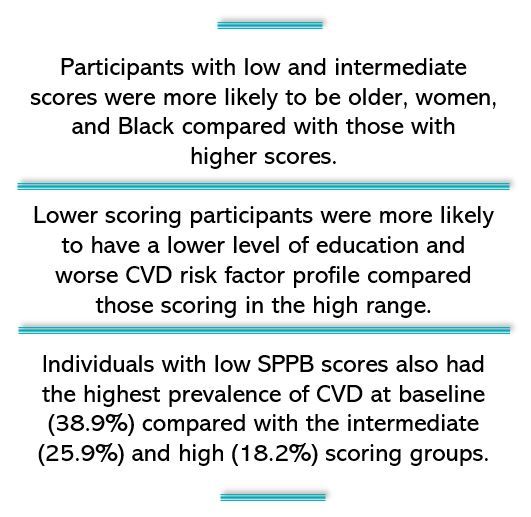- Clinical Technology
- Adult Immunization
- Hepatology
- Pediatric Immunization
- Screening
- Psychiatry
- Allergy
- Women's Health
- Cardiology
- Pediatrics
- Dermatology
- Endocrinology
- Pain Management
- Gastroenterology
- Infectious Disease
- Obesity Medicine
- Rheumatology
- Nephrology
- Neurology
- Pulmonology
Decline in Physical Function Independently Associated with CVD Risk in Older Adults: ARIC Analysis

Reduced physical function in older community dwelling adults was found independently associated with an increased risk of cardiovascular disease (CVD), including coronary heart disease (CHD), stroke, and heart failure (HF), according to a new analysis of the Atherosclerosis Risk in Communities (ARIC) study by investigators at the Johns Hopkins Bloomberg School of Public Health, in Baltimore, MD.
In a cohort of adults aged >65 years the research team found that using scores obtained from the Short Physical Performance Battery (SPPB) significantly improved predictions of CVD risk beyond traditional risk factors and regardless of individual CVD history.
Moreover, the authors report that compared with adults with high SPPB scores, those with low scores were approximately 46% more likely to experience at least 1 CVD event.
As context for their study the authors cite evidence of the age-limited prognostic ability of traditional CVD risk factors including research that found among adults aged >65 years associations between CVD and total cholesterol, systolic blood pressure, and diabetes “weakened as a function of age.” The investigators, led by Kunihiro Matsushita, MD, PhD, associate professor in the department of epidemiology at the Johns Hopkins Bloomberg School of Public Health and the Division of Cardiology at the Johns Hopkins School of Medicine, also note that although novel serum biomarkers have proven strong CVD predictors in the older population, associated costs may limit their use.
Reduced physical function, they write, “a representative phenotype of aging, has promising properties as a predictor of CVD in older adults,” including minimal cost. Their specific objective in this study was to improve understanding of the value of the SPPB score in CVD risk prediction by evaluating its relationship to CVD subtypes (CHD, stroke, HF) in a specific population.
Reduced physical function is “a representative phenotype of aging" and "has promising properties as a predictor of CVD in older adults.”
Matsushita and colleagues drew on health data from the Atherosclerosis Risk in Communities (ARIC) study visit 5 (2011–2013; all participants [n=6538] were aged >65 years) when the SPPB physical function test was first administered. The SPPB measures 3 domains of physical function: gait speed, standing balance, and chair stands. The total score, the sum of the 3 scores, ranges from 0 to 12, with higher scores indicating better function. Using the final SPPB score, participants were categorized into low, intermediate, and high groups.
The primary outcomes of interest were the association of SPPB scores with risk for CHD, stroke, and HF individually and for the composite.
FINDINGS
After exclusions, the final cohort numbered 5570 adults (57.7% women, 22% Black) with an average age of 75 years.
More than half of participants fell into the high SPPB category (57.3% [n=3194]), followed by intermediate (30.0% [n=1671]), and low (12.7% [n=705]).
The median follow up period was 7 years during which investigators recorded 930 composite CVD events (CHD 386, stroke 251, HF 529 cases). After adjusting for potential confounding variables Matsushita and team found the risk for the composite CVD outcome in the groups with low and intermediate SPPB score was significantly higher vs the in high SPPB group (hazard ratio [HR] low vs high 1.47 (95% CI, 1.20–1.79); HR intermediate vs high 1.25 (95% CI, 1.07–1.46).

Notably the team found that continuous SPPB score exhibited independent associations with each CVD outcome. Further, all the associations were largely consistent across subgroups (including participants with prevalent CVD at baseline).
Taking their analysis another step further, Matsushita et al demonstrated that adding the SPPB score to traditional risk factors in the (which group) Pooled Cohort Equation significantly improved the C-statistic for the composite CVD outcome (ΔC‐statistic 0.019 [95% CI, 0.011–0.027]).
The investigators say their findings underscore the importance of assessing physical function of older adults in clinical practice, pointing to the significant risk for falls in this group as well as for heart disease.
“Our study adds additional evidence to past research, which has demonstrated the importance of maintaining physical function at an older age,” Matsushita said. “The next questions are: what is the best way for older adults to maintain physical function, and whether interventions that improve physical function can reduce cardiovascular disease risk?”
Discussing study limitations, the investigators point to the limited racial/ethnic mix of the study population and for the inability to control for exclusion of individuals whose lack of mobility might prevent them from getting assessed at a research clinic.
Reference: Hu X, Mok Y, Ding N, et al. Low physical function after age 65 associated with future cardiovascular disease. J Am Heart Assoc. 2022;11:e025780. doi:10.1161/JAHA.121.025780
